Let’s be honest, deep down within every prepper, hides a little bit of a Burt Gummer fantasy. You’re probably very proud of your arsenal, and chances are good, you’re thinking about how to add to it. You might even have some gunsmithing skills and the ability to make your own ammo.
Yet, firearms have a limited lifespan, in a long enough catastrophe, you’ll eventually run out of ammo and/or the means to make more. Not to mention the big boom of a rifle dropping a deer in the forest is going to let everyone else for miles around know that you’re there.
So, while you’re planning to add to your arsenal and grow your ever-expanding skill set, it would only serve you to look into the weapons and techniques used by Native Americans and successful primitive people.
Atlatl
Range: 10 to 25 yards
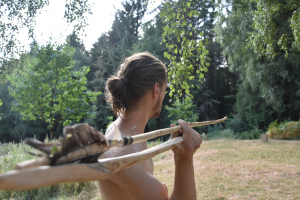
Primary Purpose: Hunting big game and defense
Power: Equivalent to a 50-pound draw bow
Time to Make: 2 to 4 hours + 2 to 4 hours for dart/spear
Materials: Wood and Bone/Antler (Optional)
If you were to look at the whole of human history, the atlatl is the number one weapon that killed the most big game. It was an advanced spear-throwing tool that many anthropologists believe gave us the edge over other primitive people like the Neanderthals and the Denisovans.
Native Americans brought this primitive, yet highly effective spear thrower with them when they crossed the land bridge. It continued to be a favorite weapon even after the introduction of the bow and arrow.
The atlatl was a spear thrower that used leverage and mechanical advantage to increase the velocity of the missile. Before its invention, Paleoindians and other primitive peoples had to thrust a spear to get it to penetrate deep enough to kill big game. Being able to throw the spear from a distance increased penetrating power without decreasing accuracy.
There are plenty of online videos that show you how to make them. You can even buy authentic ones online and use that as a guiding template to build more throwers and darts/spears. Or you can find how to make yourself one from this wilderness long-term survival guide, as long as other weapons you can make from natural materials.
Tomahawk
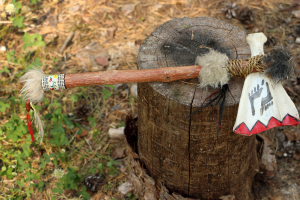
Range: Hand-to-Hand
Primary Purpose: Defense and chopping/cutting tool
Time to Make: 2 to 4 hours + 2 to 4 hours for dart/spear
Materials: Wood and Bone/Antler (Optional)
When it comes to hand-to-hand native American weapons for melee combat, few can stand up to the tomahawk. It has the speed and momentum of a machete, with a similar slashing power. With training it can also become a highly effective short-range thrown weapon.
A good tomahawk was also used as a cutting tool. Largely for chopping wood, but also for processing large game. Much in the same way you might use a hatchet today, except faster, and arguably more versatile.
One of the things to consider about a tomahawk as a melee weapon is that it doesn’t have to be lethal to be effective. The force it strikes with, and the gashing wound it makes can be cripplingly painful.
Before Europeans introduced metallurgy tomahawks were made from stone, bone, or antler fastened to a hardwood handle. You could easily make a tomahawk with quality scrap metal and a metal grinder. There are tons of online videos, and you can even buy a tomahawk online made from modern-day materials.
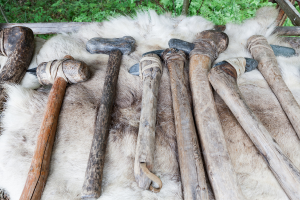
Stone Clubs
Range: Hand-to-Hand
Primary Purpose: Combat
Time to Make: 2 to 10 hours
Materials: Wood and Stone
A stone club or “War Club” is a primitive weapon used by Native Americans and many other primitive cultures. It’s essentially an older version of a European, medieval mace. It was the sort of hand-to-hand weapon that a tribe could produce relatively quickly if they had to make war.
On the face of it, a basic stone club is a rock securely fastened to the end of a 2 to 3-foot-long robust wooden handle. Like a tomahawk, you can wield it quickly and it makes a cripplingly painful wound.
Related: 23 Medicinal Plants the Native Americans Used on a Daily Basis
The common tactic is to try to hit your opponent in the head or face with the stone club before they get at you with a knife or their own war club. To that point, the early French explorers who discovered woodland Native Americans using them called the stone club a casse-tête, which loosely translates as headache or brain teaser.
On paper, it’s relatively easy to make a stone club yourself, by attaching a rock the size of your fist to a section of dried oak or similar hardwood. Some pine sap adhesive, and some creative wrapping with sinew or cordage. The problem with this design is that you’re only going to get one or perhaps two solid strikes before the stone dislodges.
To get around this, savvy Native Americans would soften leather and cover the head of the stone war club with it. Then tighten, cure, and harden it to lock it in place. It ensured they wouldn’t end up bringing a stick to a stone club fight.
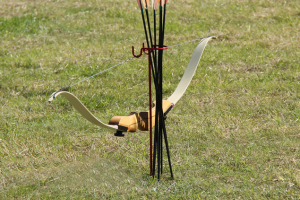
Bow and Arrow
Range: Up to 50 Yards
Primary Purpose: Hunting and Combat
Time to Make: Days to Months
Materials: Wood, Sinew, Flint, and Animal Fat
By the time Europeans interacted with Native American cultures the bow and arrow were the most common weapon used in the New World. However, there’s a widespread misconception that these were very simple weapons made from a bent sapling and some twine. A true, quality bow and arrow is a major work of art and primitive engineering that goes beyond simple bushcraft.
I had the chance to observe a workshop on how the Lakota/Sioux made bows from laminating sinew over carefully shaped, seasoned hardwood. Then waterproofed with animal fat. They demonstrated multiple bows in different stages of construction. The entire process of making one took months.
The flint-napping process of making arrowheads is also an art form onto itself. The workshop I took part in was very challenging, and even with close instruction I didn’t manage to create one worthy of tipping an arrow. Not to mention the art of fletching.
The overarching concern here is that if you aren’t adept at making a Native American bow and arrow now, and your modern bow fails in a SHTF scenario, you could be in dire straits. It’s important to know they used these weapons for both hunting and protection. In case of SHTF you can have some of these ready, but you can also try defending your property like this.
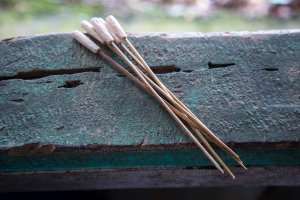 Blow Darts
Blow Darts
Range: Up to 20 Yards
Primary Purpose: Hunting
Time to Make: 1 day to 2 weeks.
Materials: Wood and Feathers
Blow darts tended to be more common with Native Americans and indigenous peoples in heavily forested areas and jungles throughout the New World. To this day tribes in the Amazon jungle use them as a primary means for hunting animals. Some will tip the darts with special poisons to maximize their effectiveness. They used to make their poison using one single plant.
There are a lot of advantages to having blowguns in your arsenal. Even if you plan on maintaining your food supply through hunting big game. Let’s say you head out to hunt deer, elk, or bear. Maybe you don’t see anything, but you know there’s one in the area.
Your stomach is grumbling on the walk back and you see a rabbit, or a squirrel that will put meat in your belly that night. Even if you have a .410 shotgun or a .22 rifle with you, the pop it makes could spook whatever big game is still in the area. Not to mention the added weight of packing yet another gun with you. If you’ve got a 2-pound blowgun in your pack, you can bring that bunny back without blowing out the area, or letting any other humans know you’re there!
Just like a Native American bow and arrow, there’s a common misconception that these are simple weapons you can slap together easily. Sourcing the correct materials is critical as you need the inner diameter of the blow gun tube and the darts to be very similar in size.
Canes and bamboo are common materials one can source in nature. However, the interior of the blow gun itself needs to be sanded and conditioned to be perfectly smooth. The slightest catch from a fibre of a splinter could grossly affect the accuracy of the dart.
The darts and the fletching that gives them accuracy are far more of an art form than the tube of the blow gun. Some great online videos can help you understand the process. With practice, and access to the right materials you can get good at making an effective blow gun capable of killing squirrels, rabbits, and birds.
Final Thoughts
The weapons used by Native Americans and other primitive people are worth considering as a backup or augmentation to your arsenal of firearms. Being proficient with atlatl or a bushcraft bow and arrow for hunting lets you save ammunition. They can even be a literal lifesaver if you run out of ammo, or something happens to one of your guns that you can’t fix.
Other Native American weapons like a blow gun and darts can also give you the ability to silently hunt small game. Along with an atlatl or a bow, they’re a great way to take down animals without spooking any other animals in the forest. They’re also silent enough not to advertise your presence to other people, the way a rifle or shotgun does.
Native American weapons like the tomahawk and the stone club are arguably better suited for melee self-defense. A single strike from one can leave your opponent with a cripplingly painful wound. A bushcraft tomahawk can even double as a cutting tool for breaking down animals and cutting cordage.
You may also like:
11 Things Native Americans Carried With Them To Survive In The Wild (Video)
Cowboy Cough Syrup with Whiskey
Better Than Walmart: Stores to Get Survival Foods for a Bargain

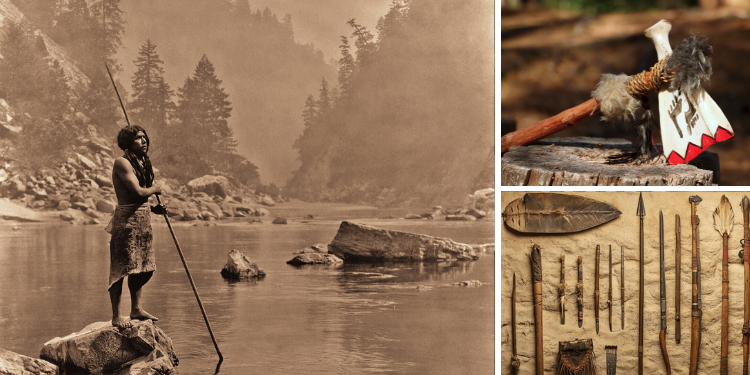





















Just watched an interesting video about making an atlatl with Tom Oar on the series, Mountain Men. What a great show!
The Donny Dust channel on youtube has an interesting atlatl segment as do a few others. Matt Graham is another one well worth watching.
If I had a steel cutting tool I could craft a reasonable Comanche style flat bow from Bois d’Arc wood, the bigger challenge would be making a good bow string. Lots of great videos online about all these weapons. The easiest ones to make aren’t often listed, a war club carved from hardwood with a slender handle and knobbed end, used by tribal warriors the world over., and a round fist sized stone attached to the end of a 3 foot horsehair reata, the other end a loop around the wrist to retain the weapon as it is swung at an enemy during a horseback charge. Ooch.
Use paracord for bow string.That stuff has dozens of uses. Get several bundles of it.
Well,,, ok then, if and when we all have retreated to these early weapons, ie clubs and rocks, alias sticks and stones… I’m pretty sure that lifes struggles would be short lived for us semi modern lifers… Sure, archery would be the number one weapon… not forgetting crossbows or any device that could fling an arrow… all semi easy to manufacture…and the one I’d go to for hunting… The sticks and stones made into clubs, well, pretty sure they’d be only valuable in close quarters combat, and not suitable for obtaining a source of protein… although in my younger days, we did hunt rabbits with hatchets, and were usually successful as rabbits always had a tendency to run a short distance and then stop commenting themselves as an easy prey…But, again, when and if we’ve reach that plateau in returning to the so called caveman days for our weaponry, our life expectancy will be cut extremely short…and as usual I did enjoy the article and the comments afterward… Live long and prosper….PS, I do maintain a compound bow, a crossbow, and a take down recurve bow, with almost plenty of arrows and bolts… just in case, don’t ya know…lol
Retreated to stone age is the reason we are all here. Maybe you get something from these articles maybe you don’t. It is what many countries have to resort to. Rocks and sticks. If the middle east hasn’t shown you anything I don’t know what to tell you. Try the WAPO?
Regarding ‘stone clubs’, the more accurate and fitting translation for ‘casse-tete’ is as follows: casse = broken, tete = head. Hence ‘broken head’ would be a better description of the end result as opposed to ‘headache’ or ‘brain teaser’, or even ‘puzzle’, as provided by Google translate.
Come On Man!!! You will not survive relying on primitive
weapons.
Fantasy has no place in prepping or survival.Period.
This article reminds me of something that the
Evil Lisa Blake would conjure up.You know the one
that stole the Good Lisa Blake’s Identity.
A good .308 rifle bolt or AR will keep you safe and fed.
In principle I agree. Unfortunately firearms do go boom even with a suppressor. For defence I will stick to an ar or even a good pistol. For hunting I will go to bows or even traps.
But making and using others mentioned in the article for recreation would be fun.
The bolt action Mauser came out 125 years ago, the 1st metal cartridge revolver 175 years ago, the semi auto handgun 130 years ago. Just about any other technology that old has changed greatly, like the gramophone, telephone, farm tractor, and auto. The Mauser 98 is primitive tech but it would be hard to build a better tool for hunting and all around survival. A good bolt action rifle, what a beautiful tool. The last time primitive weapons were widely used was in WW1 trench warfare, the deadliest tools were modern artillery and the machine gun, but close fighting was dominated by clubs, knives, and e tools. The human race, what a race…
I not think it would come to this but if needed ,
Its a good thing to learn if you run out of bullets.
Watch the movie,
Braveheart ..
What they fought wars with.
Even with high TECH WE WOULD STILL HAVE A CHANCE IN WINNING.
AND GATHER THERE WEPONS AS WE TOOK THEM DOWN WITH OURS.
PREMATIVE . but effective.
Simply well put & informative article. thank you for your time in putting it together. Reminded me of some I had forgotten. Education & survival skills go hand in hand. Soak up the information given and appreciate the time it was compiled for you to read please. Learn from it what appeals to you because you add to your arsenal of survival keys. Do not think you’re smarter than the rest of the planet with negativity. Humans aren’t dumb…we’ve been learning along time! Good knowledge & common sense & respect will get you along ways.👏
This article rings true in my heart ..My opinion…your not a prepper unless you at least take a look at being able to craft these weapons .You could be walking along in the woods and step into some kind of time portal and find yourselves in the distant pass….and guess what…. theirs Lisa…..Oh cra*!!!!!! We need to find out what’s up with these pesky Jersey drone technology orbs also . May be we can take them down with a stone club.
Nice article. I have made my own bows in the past from wood. I recommend the “Bowyers Bible “ series – really good books. Remember that building a bow is easy – arrows are super difficult. Buy arrows beforehand if you can.
Hunting small game to survive ? You’re going to be hungry if you plan on surviving that way. Get in kindle/amazon and obtain some books on early trapping & snaring.
Learn to make your own traps/snares.
Traps/snares will keep you fed. Hunt while you check traps. Traps are hunting 24/7/365…..you are not.
Just my two cents worth. I really enjoy this forum & find the comments to be informative. Everybody stay safe !
I have a couple of long bows, but all purchased, not built. My 1st one was a high school P.E. fiberglass bow that an Uncle gave me. Snot green in color, the pull about 25 lbs. Another bow is made from PVC pipe. A good option to build now – Internet has plenty of instructions. Very light weight.
Probably too low in power for deer hunting, but a wise old deer hunter told me having exceedingly sharp broad heads make up a lot of ground in effectiveness. My DIY built arrows have MA 3 blade heads that glue on to shaft.
I think small game and birds are a better option for foraging. Small amount of meat and far easier to consume and process. Hard hunted deer become noctournal and are much harder to hunt long term.
Don’t forget about fishing gear. What kinds of fishing equipment did Native Americans use?
um, those with THIS IS THE ANSWER, think about it.
You live in downtown manhatten – your screwed in my book, but good luck.
you live in Choteau Montanna, different answers ! ! and you will be comfortable.
” I dont think primitive weapons” well, Primitive = QUIET and sustainable.
That .308, the NOISE = a tracer, it works in both directions, HELL in some places, Grizzley bears MOVE TO gun sounds for free food ( where protected). You think people wont ? Those that want your food harvest or your food stockpile , women, Amo, axe, rope, saw ETC, will now know your location. A crossbolt Bolt = SILENCED firepower.